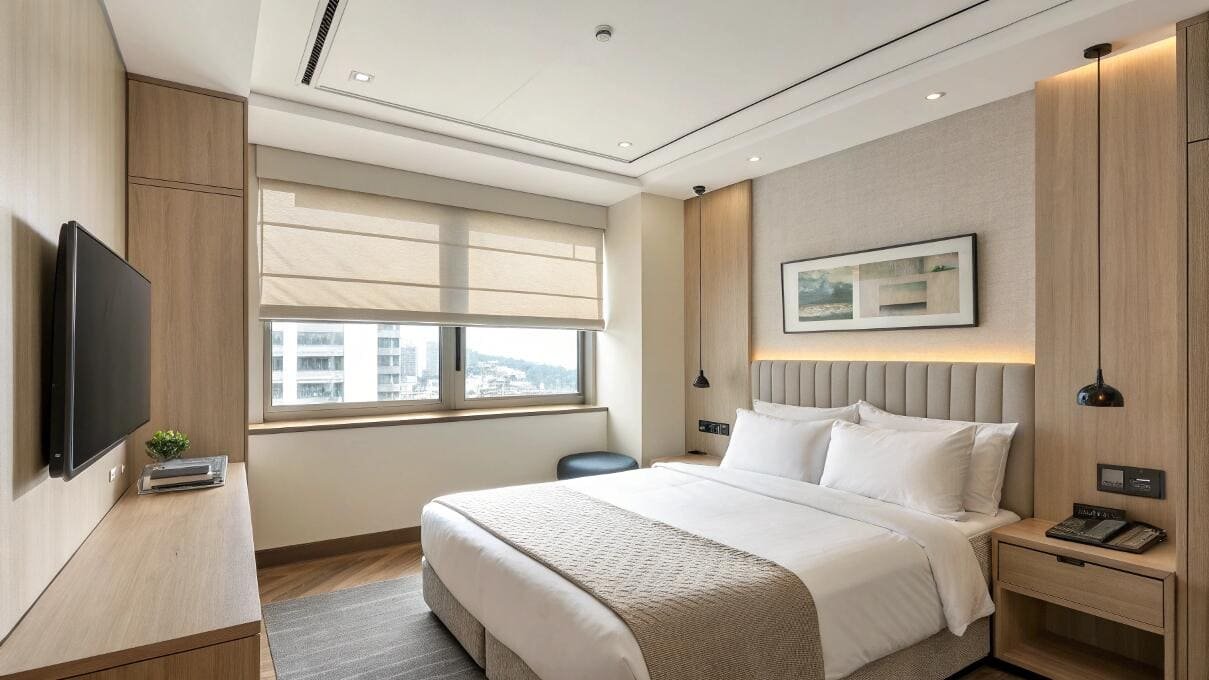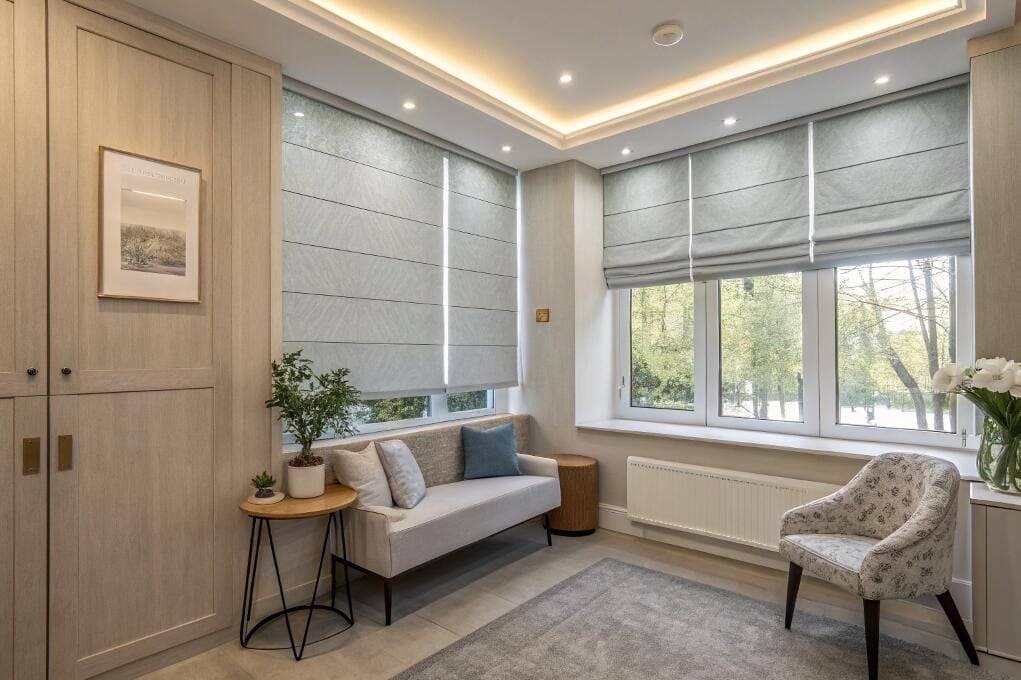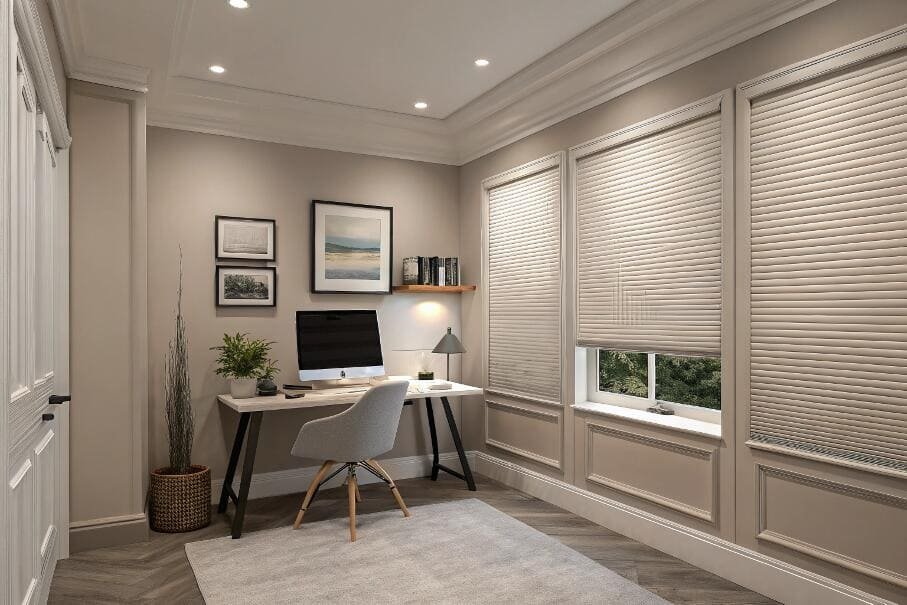Struggling with a small, cramped room that feels dark and enclosed? The wrong window treatments can shrink a space, blocking precious light and adding visual clutter.
The solution is to choose treatments that maximize light and create an illusion of height. Think light-colored roller shades[^1], sleek vertical blinds, or sheer fabrics mounted high and wide to visually expand your windows and the room itself.

As a specialist providing shading solutions for countless projects, from compact hotel rooms to efficient office pods, I know that small spaces present a unique design challenge. The goal is always to create a feeling of openness and comfort. Window treatments are one of the most powerful tools to achieve this. They don't just control light; they direct the eye, influence perception, and can fundamentally change the character of a room. Let's explore how to use them to your advantage.
What window treatment makes a room look bigger?
You're trying to furnish a small space and every inch counts. You need a window treatment that doesn't just fit the window, but actually helps enlarge the room visually.
Simple, light-colored blinds that blend with the wall are best for making a room look bigger. Roller shades, vertical blinds[^2], and cellular shades[^3] with a slim profile minimize visual clutter. Mounting them higher and wider than the actual window frame creates an illusion of size.

From my experience on commercial and high-density residential projects, the secret lies in creating long, clean vertical and horizontal lines. You want to trick the eye into seeing more height and width than is actually there. Bulky, dark, or heavily patterned treatments break up these lines and make a room feel smaller and more chaotic. The key is a minimalist approach that prioritizes light and seamlessness.
Techniques for Visual Expansion
- Color and Pattern: Stick to solid, light colors—white, beige, or light gray. Choose a color that matches or is very close to your wall color. This makes the blinds recede into the wall, creating a continuous, unbroken surface that feels more expansive.
- Mounting Strategy: This is the most effective trick.
- Go High: Mount the blind's headrail 6-12 inches above the window frame. This draws the eye upward and creates the illusion of a taller ceiling.
- Go Wide: Extend the blind 3-6 inches beyond the window frame on each side. When the blind is open, it exposes the entire glass pane, maximizing light and making the window itself appear grander.
- Profile and Style: Choose treatments with a low profile.
| Blind Type | Why It Works for Small Spaces | Best For |
|---|---|---|
| Roller Shades | Disappear almost completely when rolled up, offering a clean view. | Minimalist designs, maximizing daylight. |
| Vertical Blinds | Emphasize height, great for sliding doors or tall, narrow windows. | Small rooms with large glass doors. |
| Cellular Shades | Have a very slim stack when raised, preserving the view. | Rooms needing extra insulation. |
| Venetian Blinds | Light colors and thin slats offer adjustable, diffused light. | Offices or kitchens where light control is key. |
Avoid heavy drapes, dark wood blinds, or complex Roman shades with large folds, as these add visual weight that can overwhelm a small space.
What are the window treatments to block sunlight in a small room?
Even in a small room, sometimes you need complete darkness. How do you block out all sunlight for sleep or a presentation without using a heavy treatment that makes the room feel smaller?
For total sun-blocking, choose dual roller shades[^4], cellular shades with blackout fabric, or roller blinds with side channels. These options provide 100% light blockage with a minimal, sleek profile that won't overwhelm a small space.

The challenge in a small room is achieving functionality without sacrificing the feeling of space. You need a solution that can disappear when you want light but perform perfectly when you need darkness. This is why integrated systems and specialized fabrics are so important. In projects like boutique hotels or compact apartments, we rely on technology that packs maximum performance into the slimmest possible design. Heavy, light-blocking curtains are not the answer.
High-Performance Light Blocking Solutions
- Dual Roller Shades: This is my top recommendation for multi-functional small spaces. The system combines two fabrics in one sleek headrail:
- A sheer or solar screen for daytime light filtering.
- A full blackout fabric for nighttime privacy and darkness.
This gives you complete flexibility without requiring two separate installations. Some high-tech versions use metallized fabric that can block up to 97% of UV rays, keeping the room cool.
- Blackout Cellular (Honeycomb) Shades: These are fantastic insulators. The honeycomb-shaped cells trap air, which provides a thermal barrier. When made with a blackout fabric (often lined with Mylar), they block virtually all light. Their slim stack when raised makes them ideal for small windows.
- Roller Blinds with Side Channels: For true, cinema-grade darkness, this is the ultimate solution. A standard roller blind is fitted into U-shaped channels on the sides and bottom of the window frame. This eliminates the "halo" of light that leaks around the edges of a normal blind, which is especially noticeable on small windows.
| Solution | Light Blocking Level | Best Feature for Small Spaces |
|---|---|---|
| Dual Roller Shades | 95% - 99% | Two-in-one functionality (sheer + blackout). |
| Blackout Cellular Shades | 99% | Excellent insulation and slim profile. |
| Roller with Side Channels | 100% | Complete, gap-free darkness. |
These solutions prove you don’t need bulky curtains to achieve perfect darkness. Modern fabric and hardware technology deliver superior performance in a minimalist package.
How do you maximize natural light in a room with small windows?
Your room has small windows, and you want to make the absolute most of every bit of sunlight. How do you dress the windows to amplify light rather than block it?
To maximize light, use translucent or sheer window treatments that diffuse light without obstructing it. Solar shades, light-colored venetian blinds, and sheer curtains mounted high and wide are excellent choices. Keeping treatments fully open during the day is also key.

When light is scarce, every decision matters. The goal is to invite light in, bounce it around the room, and avoid any visual barriers. In my experience, this requires a two-part strategy: choosing the right translucent window treatment and using interior design tricks to amplify its effect. You want to treat the window not just as an opening, but as the primary light source for the entire space.
Strategies to Amplify and Brighten
-
Choose Translucent Materials:
- Solar Shades: These are a modern marvel. They are designed to cut glare and UV rays while remaining transparent. A solar shade with a high openness factor (10-14%) will let in a huge amount of light while softening its intensity. Solar shades are a great solution for maintaining views while blocking the sun's negative effects.
- Sheer Fabrics: Sheer roller shades or traditional sheer curtains provide privacy while bathing the room in a soft, diffused glow.
- Light-Filtering Cellular Shades: These offer privacy but are translucent enough to let a significant amount of light pass through, giving the room a luminous quality.
-
Keep Blinds Open and Unobstructed:
- Mount blinds high and wide so that when they are fully open, the stack sits above and beside the window frame, not over the glass. This ensures 100% of the possible light can enter.
- Avoid placing bulky furniture directly in front of the window.
-
Decorate for Light Amplification:
- Paint: Use light, reflective paint colors (like satin or eggshell finishes in white, off-white, or pale pastels) on the walls and ceiling.
- Mirrors: Place a large mirror on the wall opposite the window. This is the oldest trick in the book because it works—it will double the amount of perceived light and create an illusion of depth.
- Reflective Surfaces: Use furniture and decor with reflective surfaces[^5], like glass coffee tables, metallic accents, and high-gloss finishes, to bounce light around the room.
Conclusion
To visually expand a small space, choose light-colored, minimalist window treatments. Mount them high and wide to create an illusion of height and let in maximum light, transforming the room's entire feel.
Optimize Your Small Space Project
Planning a project with small rooms? Let's specify the perfect window treatments to maximize space, light, and value. We provide technical advice and tailored quotes to ensure your design succeeds.
Contact me with your project details at info@velablinds.com to get started.
Extended FAQ Section
People also ask
Should blinds match the wall color or window trim in a small room?
In a small room, it's almost always best to match the blinds to the wall color. This creates a monochromatic, seamless look that makes the walls feel continuous and expansive. When blinds blend in with the wall, they don’t visually break up the space, which helps the room feel larger. Matching them to a contrasting window trim color can draw attention to the window's small size and create choppy visual lines that make the room feel more cluttered and confined.
Are cellular shades a good choice for small windows?
Yes, cellular shades (or honeycomb shades) are an excellent choice for small windows. Their biggest advantage is their extremely slim profile and small stack height. When raised, they compress into a very small, tidy stack at the top of the window, leaving the maximum amount of glass exposed to let in light. They are also available in light-filtering and blackout options, offering great versatility. Their insulating properties are an added bonus, helping to keep small rooms comfortable.
What is the best way to hang curtains to make a small room look bigger?
The best way is to use the "high and wide" method. Install the curtain rod at least 6-12 inches above the top of the window frame, as close to the ceiling as is practical. Extend the rod 6-10 inches beyond the frame on each side. This tricks the eye into seeing a taller and wider window. Use lightweight, sheer, or light-colored curtain panels and ensure that when they are open, the fabric hangs entirely against the wall, not covering any part of the glass.
---
[^1]: Find out why light-colored roller shades are a perfect choice for small spaces, enhancing brightness and openness.
[^2]: Discover the advantages of vertical blinds for small rooms, including their ability to emphasize height and maximize light.
[^3]: Find out why cellular shades are an excellent choice for small windows, offering insulation and a sleek profile.
[^4]: Explore the functionality of dual roller shades, perfect for small spaces needing both light filtering and blackout options.
[^5]: Learn how using reflective surfaces can bounce light around your small room, creating a brighter atmosphere.Partner with VelaBlinds for Your Next Project
Smart window treatments shouldn't be complicated. After working with 500+ distributors and contractors worldwide, I've streamlined the process to get you quality products, competitive pricing, and reliable support - every time.
Why project professionals choose VelaBlinds:
- ✅ Fast, Accurate Quotes - Detailed specs and pricing within 24 hours
- ✅ Transparent Pricing - No hidden fees, volume discounts clearly outlined
- ✅ Quality Assurance - Direct partnerships with certified OEM manufacturers
- ✅ Project Support - Dedicated account manager from quote to delivery
Start your next project:
📧 Quick Quote: Send your requirements to info@velablinds.com
📱 Direct Contact: WhatsApp +86 137 2012 8317
🌐 Browse Solutions: https://velablinds.com/
📁 Product Resources: Access spec sheets, catalogs & project files
Jimmy Chen, Founder
"I built VelaBlinds to solve the real challenges I faced as a project buyer - long lead times, unclear specs, and unreliable suppliers. Let's discuss how we can power your projects with smarter blinds."
Serving distributors and contractors across North America, Europe, and Australia since 2018.



